Demonstrating the Use of the Yield-Gap Concept on Crop Model Calibration in Data-Poor Regions: An Application to CERES-Wheat Crop Model in Greece
Abstract
1. Introduction
2. Materials and Methods
2.1. Yield Trials
2.2. Methods
2.2.1. The CERES-Wheat Crop Model
2.2.2. The GLUE Coefficient Estimator
2.2.3. Estimating Genetic Parameters for CERES-Wheat
Coefficients Related to Crop Development
Coefficients Related to Crop Yield
2.2.4. Calibration Strategies
Calibration Based on Yield Gap Analysis (YgC)
Traditional Calibration (TrC)
2.2.5. Sensitivity Analysis
2.2.6. Statistical Measures
3. Results
3.1. Yield Gap Analysis
3.2. Selection of Genetic Coefficients
3.3. Anthesis and Maturity fitting
3.4. Crop Yield Fitting
3.5. Sensitivity Analysis
4. Discussion
- Regarding genetic coefficients: (i) the fitting process for all cultivars approximated the site yield by favoring grain numbers (G1) for the YgC_adj strategy over grain weight (G3) for the YgC_unadj strategy, while similar values for grain size (G2) were found for both strategies; and (ii) compared to the rainfed strategies (TrC and DSSAT 3.5), similar values for G2 and significantly higher values for G1 were obtained for all cultivars with the YgC_adj strategy. The values for G3 from the YgC_adj strategy were lower than these found with DSSAT v3.5 and higher (except for Simeto) than the respective obtained with the TrC strategy. Notably, the selection of the most appropriate genetic parameters in this study illustrated that statistical measures (such as MAE and RMSE) more relevant for the intended application could be preferred over the probability estimated by GLUE since different sets of genetic parameters produce similar statistical measure estimates.
- The yield gap-based calibration strategy accounting for year-to-year variability of Yrg (YgC_adj) was: (i) superior to the “traditional” strategy (TrC) for all cultivars, as MAE and RMSE were substantially lower with the former strategy and the slopes of the regression lines were closer to the 1:1 line; (ii) more effective than the respective calibration strategy using an average site value of Yrg (YgC_unadj) showing much lower relative MAE (from 36 to 46% for YgC_unadj vs. 8 to 10% for YgC_adj) and RMSE (from 48 to 57% for YgC_unadj vs. 10 to 13% for YgC_adj) values. These results confirm the importance of incorporating temporal variability into yield gap analysis conducted at the farming systems level, as noted by Silva and Ramisch (2018) [49]; and (iii) slightly inferior to calibration with DSSAT v.3.5, which presented closer to 1:1 regression lines and lower relative MAE and RMSE values (6% and 8%, respectively, for Mexicali, 4% and 5%, respectively, for Sifnos, and 5% and 7%, respectively, for Simeto). The different results show the sensitivity of the two crop model versions to the initial soil moisture conditions assumed by Symeonidis (2011) [12]. The substantial impacts of uncertainties in soil and management information on crop simulated water, N, and yield were confirmed in recent studies [50,51].
- The sensitivity analysis of simulated wheat development and yield, applying the genetic parameters produced with the YgC_adj strategy, based on climate change projections from the ensemble of 11 high-resolution EURO-CORDEX regional climate model simulations, under the influence of the moderate mitigation emission scenario RCP4.5 for the future periods 2021–2050 (NF) and 2071–2100 (EOC), revealed: alike earlier anthesis and maturity (by 7–8 and 12–13 days, on average, for the NF and the EOC, respectively) and decreased yield (from 2.2 to 3.9% for the NF period, and from 5.0 to 7.1% for the EOC) as a result of the increased temperature and solar radiation (by 1.4 °C and 1.3%, for the NF, and 2.3 °C and 1.7%, for the end EOC, respectively).
5. Conclusions
Supplementary Materials
Author Contributions
Funding
Data Availability Statement
Acknowledgments
Conflicts of Interest
References
- Schulze, R.; Durand, W. Maize Production in South Africa and Climate Change. In Handbook for Farmers, Officials and Other Stakeholders on Adaptation to Climate Change in the Agriculture Sector within South Africa; Schulze, R.E., Ed.; Section C: Crops in South Africa and Climate Change, South Africa, 2016. [Google Scholar]
- Asseng, S.; Zhu, Y.; Basso, B.; Wilson, T.; Cammarano, D. Simulation Modeling: Applications in Cropping Systems. Encycl. Agric. Food Syst. 2014, 5, 102–112. [Google Scholar] [CrossRef]
- Kephe, P.N.; Ayisi, K.K.; Petja, B.M. Challenges and opportunities in crop simulation modelling under seasonal and projected climate change scenarios for crop production in South Africa. Agric. Food Secur. 2021, 10, 10. [Google Scholar] [CrossRef]
- Wallach, D.; Palosuo, T.; Thorburn, P.; Hochman, Z.; Gourdain, E.; Andrianasolo, F.; Asseng, S.; Basso, B.; Buis, S.; Crout, N.; et al. The chaos in calibrating crop models: Lessons learned from a multi-model calibration exercise. Environ. Model. Softw. 2021, 145, 105206. [Google Scholar] [CrossRef]
- Grassini, P.; van Bussel, L.G.J.; Van Wart, J.; Wolf, J.; Claessens, L.; Yang, H.; Boogaard, H.; de Groot, H.; van Ittersum, M.K.; Cassman, K.G. How good is good enough? Data requirements for reliable crop yield simulations and yield-gap analysis. Field Crop. Res. 2015, 177, 49–63. [Google Scholar] [CrossRef]
- Jones, J.W.; He, J.; Boote, K.J.; Wilkens, P.; Porter, C.H.; Hu, Z. Estimating DSSAT Cropping System Cultivar-Specific Parameters Using Bayesian Techniques. Methods Introd. Syst. Model. into Agric. Res. 2011, 2, 365–393. [Google Scholar] [CrossRef]
- Seidel, S.J.; Palosuo, T.; Thorburn, P.; Wallach, D. Towards improved calibration of crop models—Where are we now and where should we go? Eur. J. Agron. 2018, 94, 25–35. [Google Scholar] [CrossRef]
- Annicchiarico, P. Genotype x Environment Interaction: Challenges and Opportunities for Plant Breeding and Cultivar Recommendations; FAO: Rome, Italy, 2002. [Google Scholar]
- Choruma, D.; Balkovic, J.; Odume, O.N. Calibration and validation of the EPIC model for maize production in the Eastern Cape, South Africa. Agronomy 2019, 9, 494. [Google Scholar] [CrossRef]
- Jones, J.W.; Antle, J.M.; Basso, B.; Boote, K.J.; Conant, R.T.; Foster, I.; Godfray, H.C.J.; Herrero, M.; Howitt, R.E.; Janssen, S.; et al. Toward a new generation of agricultural system data, models, and knowledge products: State of agricultural systems science. Agric. Syst. 2017, 155, 269–288. [Google Scholar] [CrossRef]
- Van Ittersum, M.K.; Cassman, K.G.; Grassini, P.; Wolf, J.; Tittonell, P.; Hochman, Z. Yield gap analysis with local to global relevance-A review. Field Crop. Res. 2013, 143, 4–17. [Google Scholar] [CrossRef]
- Symeonidis, K.; Mavromatis, T.; Kotzamanidis, S. Investigating with the Ceres-Wheat Model the Impacts of Soil and Climate Factors on Durum Wheat Performance and Earliness in Northern Greece. Springer Atmospheric Sciences; Springer: Berlin/Heidelberg, Germany, 2013. [Google Scholar] [CrossRef]
- Jones, C.A.; Kiniry, J.R.; Dyke, P.T. CERES-Maize: A Simulation Model of Maize Growth and Development; A&M Univ. Press: College Station, TX, USA, 1986. [Google Scholar]
- Suleiman, A.A.; Ritchie, J.T. Estimating Saturated Hydraulic Conductivity from Soil Porosity. Trans. ASAE 2001, 44, 235. [Google Scholar] [CrossRef]
- Hoogenboom, G.; Porter, C.H.; Boote, K.J.; Shelia, V.; Wilkens, P.W.; Singh, U.; White, J.W.; Asseng, S.; Lizaso, J.I.; Moreno, L.P.; et al. The DSSAT Crop Modeling Ecosystem, In Advances in Crop Modelling for a Sustainable Agriculture; Burleigh Dodds Science Publishing: Cambridge, UK, 2019; pp. 173–216. [Google Scholar]
- Jones, J.W.; Hoogenboom, G.; Porter, C.H.; Boote, K.J.; Batchelor, W.D.; Hunt, L.A.; Wilkens, P.W.; Singh, U.; Gijsman, A.J.; Ritchie, J.T. The DSSAT cropping system model. Eur. J. Agron. 2003, 18, 235–265. [Google Scholar] [CrossRef]
- Dettori, M.; Cesaraccio, C.; Motroni, A.; Spano, D.; Duce, P. Using CERES-Wheat to simulate durum wheat production and phenology in Southern Sardinia, Italy. Field Crop. Res. 2011, 120, 179–188. [Google Scholar] [CrossRef]
- Dettori, M.; Cesaraccio, C.; Duce, P. Simulation of climate change impacts on production and phenology of durum wheat in Mediterranean environments using CERES-Wheat model. Field Crop. Res. 2017, 206, 43–53. [Google Scholar] [CrossRef]
- Eitzinger, J.; Trnka, M.; Hösch, J.; Žalud, Z.; Dubrovský, M. Comparison of CERES, WOFOST and SWAP models in simulating soil water content during growing season under different soil conditions. Ecol. Modell. 2004, 171, 223–246. [Google Scholar] [CrossRef]
- Beven, K.; Binley, A. The future of distributed models: Model calibration and uncertainty prediction. Hydrol. Process. 1992, 6, 279–298. [Google Scholar] [CrossRef]
- Franks, S.W.; Gineste, P.; Beven, K.J.; Mérot, P. On constraining the predictions of a distributed model: The incorporation of fuzzy estimates of saturated areas into the calibration process. Water Resour. Res. 1998, 34, 787–797. [Google Scholar] [CrossRef]
- Schulz, K.; Beven, K.; Huwe, B. Equifinality and the Problem of Robust Calibration in Nitrogen Budget Simulations. Soil Sci. Soc. Am. J. 1999, 63, 1934–1941. [Google Scholar] [CrossRef]
- Romanowicz, R.J.; Beven, K.J. Comments on generalised likelihood uncertainty estimation. Reliab. Eng. Syst. Saf. 2006, 91, 1315–1321. [Google Scholar] [CrossRef]
- Niu, J.Y.; Gan, Y.T.; Zhang, J.W.; Yang, Q.F. Postanthesis dry matter accumulation and redistribution in spring wheat mulched with plastic film. Crop. Sci. 1998, 38, 1562–1568. [Google Scholar] [CrossRef]
- Zhang, D.; Wang, H.; Li, D.; Li, H.; Ju, H.; Li, R.; Batchelor, W.D.; Li, Y. DSSAT-CERES-Wheat model to optimize plant density and nitrogen best management practices. Nutr. Cycl. Agroecosyst. 2019, 114, 19–32. [Google Scholar] [CrossRef]
- Mereu, V.; Gallo, A.; Spano, D. Optimizing genetic parameters of CSM-CERES wheat and CSM-CERES maize for durum wheat, common wheat, and maize in Italy. Agronomy 2019, 9, 665. [Google Scholar] [CrossRef]
- Rinaldi, M. Water availability at sowing and nitrogen management of durum wheat: A seasonal analysis with the CERES-Wheat model. Field Crop. Res. 2004, 89, 27–37. [Google Scholar] [CrossRef]
- Ji, J.; Cai, H.; He, J.; Wang, H. Performance evaluation of CERES-Wheat model in Guanzhong Plain of Northwest China. Agric. Water Manag. 2014, 144, 1–10. [Google Scholar] [CrossRef]
- Rattalino Edreira, J.I.; Andrade, J.F.; Cassman, K.G.; van Ittersum, M.K.; van Loon, M.P.; Grassini, P. Spatial frameworks for robust estimation of yield gaps. Nat. Food 2021, 2, 773–779. [Google Scholar] [CrossRef]
- van Bussel, L.G.J.; Grassini, P.; Van Wart, J.; Wolf, J.; Claessens, L.; Yang, H.; Boogaard, H.; de Groot, H.; Saito, K.; Cassman, K.G.; et al. From field to atlas: Upscaling of location-specific yield gap estimates. Field Crop. Res. 2015, 177, 98–108. [Google Scholar] [CrossRef]
- Habte, A.; Worku, W.; Gayler, S.; Ayalew, D.; Mamo, G. Model-based yield gap analysis and constraints of rainfed sorghum production in Southwest Ethiopia. J. Agric. Sci. 2020, 158, 855–869. [Google Scholar] [CrossRef]
- Global Yield Gap Atlas. Available online: https://www.yieldgap.org/ (accessed on 7 June 2023).
- Grassini, P.; Cassman, K.G.; van Ittersum, M.K. Exploring Maize Intensification with the Global Yield Gap Atlas. Better Crop. Plant Food 2017, 101, 7–9. [Google Scholar]
- De Wit, A.; Boogaard, H.; Fumagalli, D.; Janssen, S.; Knapen, R.; van Kraalingen, D.; Supit, I.; van der Wijngaart, R.; van Diepen, K. 25 years of the WOFOST cropping systems model. Agric. Syst. 2019, 168, 154–167. [Google Scholar] [CrossRef]
- Pirttioja, N.; Palosuo, T.; Fronzek, S.; Räisänen, J.; Rötter, R.P.; Carter, T.R. Using impact response surfaces to analyse the likelihood of impacts on crop yield under probabilistic climate change. Agric. For. Meteorol. 2019, 264, 213–224. [Google Scholar] [CrossRef]
- Ceglar, A.; van der Wijngaart, R.; de Wit, A.; Lecerf, R.; Boogaard, H.; Seguini, L.; van den Berg, M.; Toreti, A.; Zampieri, M.; Fumagalli, D.; et al. Improving WOFOST model to simulate winter wheat phenology in Europe: Evaluation and effects on yield. Agric. Syst. 2019, 168, 168–180. [Google Scholar] [CrossRef]
- Jacob, D.; Petersen, J.; Eggert, B.; Alias, A.; Christensen, O.B.; Bouwer, L.M.; Braun, A.; Colette, A.; Déqué, M.; Georgievski, G.; et al. EURO-CORDEX: New high-resolution climate change projections for European impact research. Atmosphere 2014, 14, 563–578. [Google Scholar] [CrossRef]
- Vautard, R.; Gobiet, A.; Jacob, D.; Belda, M.; Colette, A.; Déqué, M.; Fernández, J.; García-Díez, M.; Goergen, K.; Güttler, I.; et al. The simulation of European heat waves from an ensemble of regional climate models within the EURO-CORDEX project. Clim. Dyn. 2013, 41, 2555–2575. [Google Scholar] [CrossRef]
- Georgoulias, A.K.; Akritidis, D.; Kalisoras, A.; Kapsomenakis, J.; Melas, D.; Zerefos, C.S.; Zanis, P. Climate change projections for Greece in the 21st century from high-resolution EURO-CORDEX RCM simulations. Atmos. Res. 2022, 271, 106049. [Google Scholar] [CrossRef]
- Hinkle, D.E.; Wiersma, W.; Jurs, S. Applied Statistics for the Behavioral Sciences, 5th ed.; Houghton Mifflin: Boston, MA, USA, 2003. [Google Scholar]
- Bao, Y.; Hoogenboom, G.; McClendon, R.; Vellidis, G. A comparison of the performance of the CSM-CERES-Maize and EPIC models using maize variety trial data. Agric. Syst. 2017, 150, 109–119. [Google Scholar] [CrossRef]
- James, G.; Witten, D.; Hastie, T.; Tibshirani, R. An Introduction to Statistical Learning wth Application in R; Springer: New York, NY, USA, 2013; ISBN 9781461471370. [Google Scholar]
- Kassie, B.T.; Asseng, S.; Porter, C.H.; Royce, F.S. Performance of DSSAT-Nwheat across a wide range of current and future growing conditions. Eur. J. Agron. 2016, 81, 27–36. [Google Scholar] [CrossRef]
- Rezzoug, W.; Gabrielle, B.; Suleiman, A.; Benabdeli, K. Application and evaluation of the DSSAT-wheat in the Tiaret region of Algeria. J. Agric. Res. 2008, 3, 284–296. [Google Scholar]
- Ritchie, J.T.; Otter, S. Description and performance of CERES-Wheat: A user-oriented wheat yield model. Usda-Ars 1985, 38, 159–175. [Google Scholar]
- Life ADAPT2CLIMA. Adaptation to Climate Change Impacts on the Mediterranean islands’ Agriculture. 2017. Available online: http://adapt2clima.eu/uploads/2017/adapt2clima_Deliverable_C.4.2_final.pdf (accessed on 7 June 2023).
- Challinor, A.J.; Watson, J.; Lobell, D.B.; Howden, S.M.; Smith, D.R.; Chhetri, N. A meta-analysis of crop yield under climate change and adaptation. Nat. Clim. Chang. 2014, 4, 287–291. [Google Scholar] [CrossRef]
- Rosenzweig, C.; Elliott, J.; Deryng, D.; Ruane, A.C.; Müller, C.; Arneth, A.; Boote, K.J.; Folberth, C.; Glotter, M.; Khabarov, N.; et al. Assessing agricultural risks of climate change in the 21st century in a global gridded crop model intercomparison. Proc. Natl. Acad. Sci. USA 2014, 111, 3268–3273. [Google Scholar] [CrossRef]
- Silva, J.V.; Ramisch, J.J. Whose gap counts? the role of yield gap analysis within a development-oriented agronomy. Exp. Agric. 2018, 55, 311–338. [Google Scholar] [CrossRef]
- Archontoulis, S.V.; Castellano, M.J.; Licht, M.A.; Nichols, V.; Baum, M.; Huber, I.; Martinez-Feria, R.; Puntel, L.; Ordóñez, R.A.; Iqbal, J.; et al. Predicting crop yields and soil-plant nitrogen dynamics in the US Corn Belt. Crop. Sci. 2020, 60, 721–738. [Google Scholar] [CrossRef]
- Basso, B.; Hyndman, D.W.; Kendall, A.D.; Grace, P.R.; Robertson, G.P. Can impacts of climate change and agricultural adaptation strategies be accurately quantified if crop models are annually re-initialized? PLoS ONE 2015, 10, 0127333. [Google Scholar] [CrossRef]
- Timsina, J.; Humphreys, E. Performance of CERES-Rice and CERES-Wheat models in rice-wheat systems: A review. Agric. Syst. 2006, 90, 5–31. [Google Scholar] [CrossRef]
- Wei, Y.; Ru, H.; Leng, X.; He, Z.; Ayantobo, O.O.; Javed, T.; Yao, N. Better Performance of the Modified CERES-Wheat Model in Simulating Evapotranspiration and Wheat Growth under Water Stress Conditions. Agriculture 2022, 12, 1902. [Google Scholar] [CrossRef]
- Ollenburger, M.; Kyle, P.; Zhang, X. Uncertainties in estimating global potential yields and their impacts for long-term modeling. Food Secur. 2022, 14, 1177–1190. [Google Scholar] [CrossRef]
- Lobell, D.B.; Cassman, K.G.; Field, C.B. Crop yield gaps: Their importance, magnitudes, and causes. Annu. Rev. Environ. Resour. 2009, 34, 179–204. [Google Scholar] [CrossRef]
- Grassini, P.; Thorburn, J.; Burr, C.; Cassman, K.G. High-yield irrigated maize in the Western U.S. Corn Belt: I. On-farm yield, yield potential, and impact of agronomic practices. Field Crop. Res. 2011, 120, 142–150. [Google Scholar] [CrossRef]
- Laborte, A.G.; de Bie, K.C.A.J.M.; Smaling, E.M.A.; Moya, P.F.; Boling, A.A.; Van Ittersum, M.K. Rice yields and yield gaps in Southeast Asia: Past trends and future outlook. Eur. J. Agron. 2012, 36, 9–20. [Google Scholar] [CrossRef]
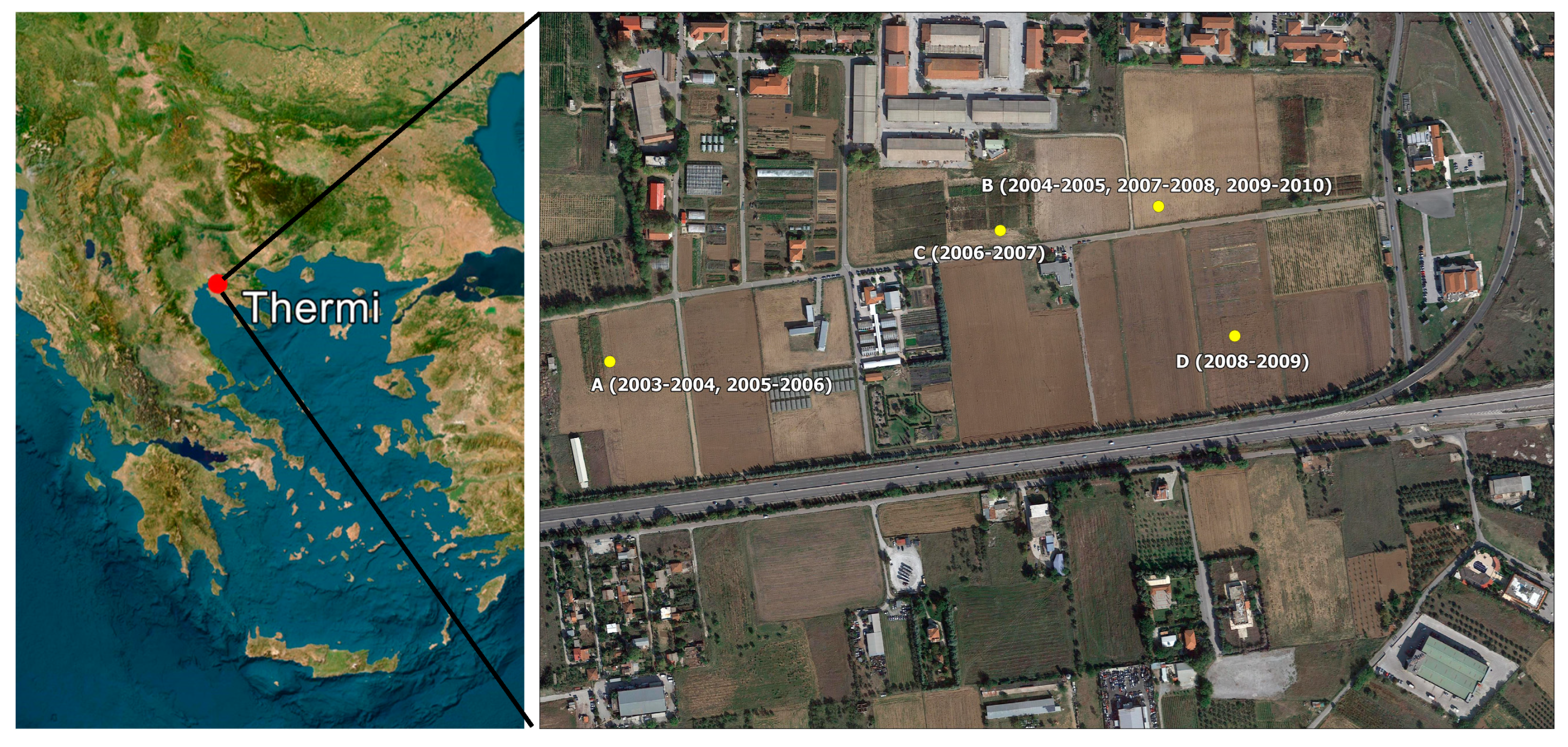
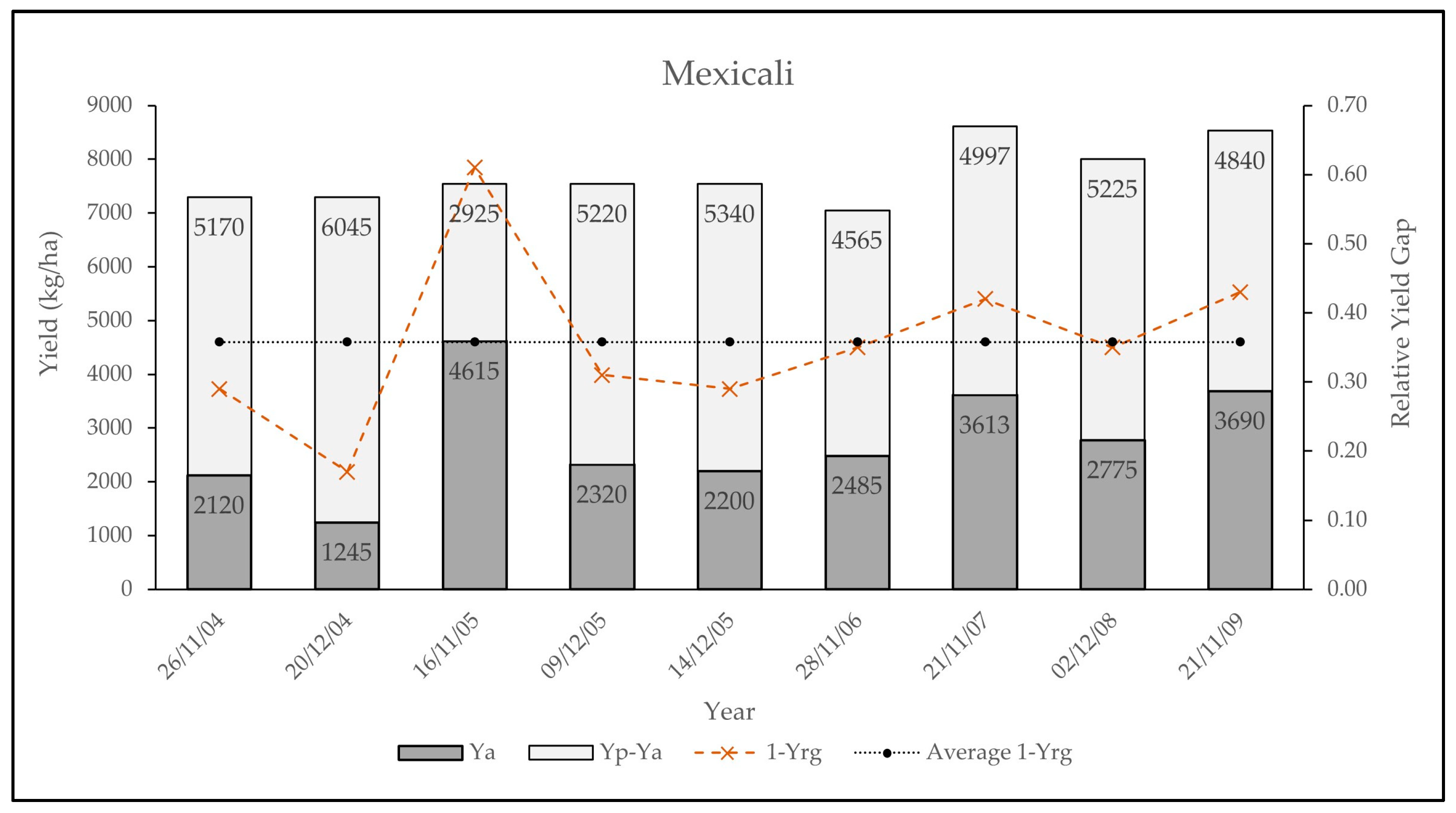
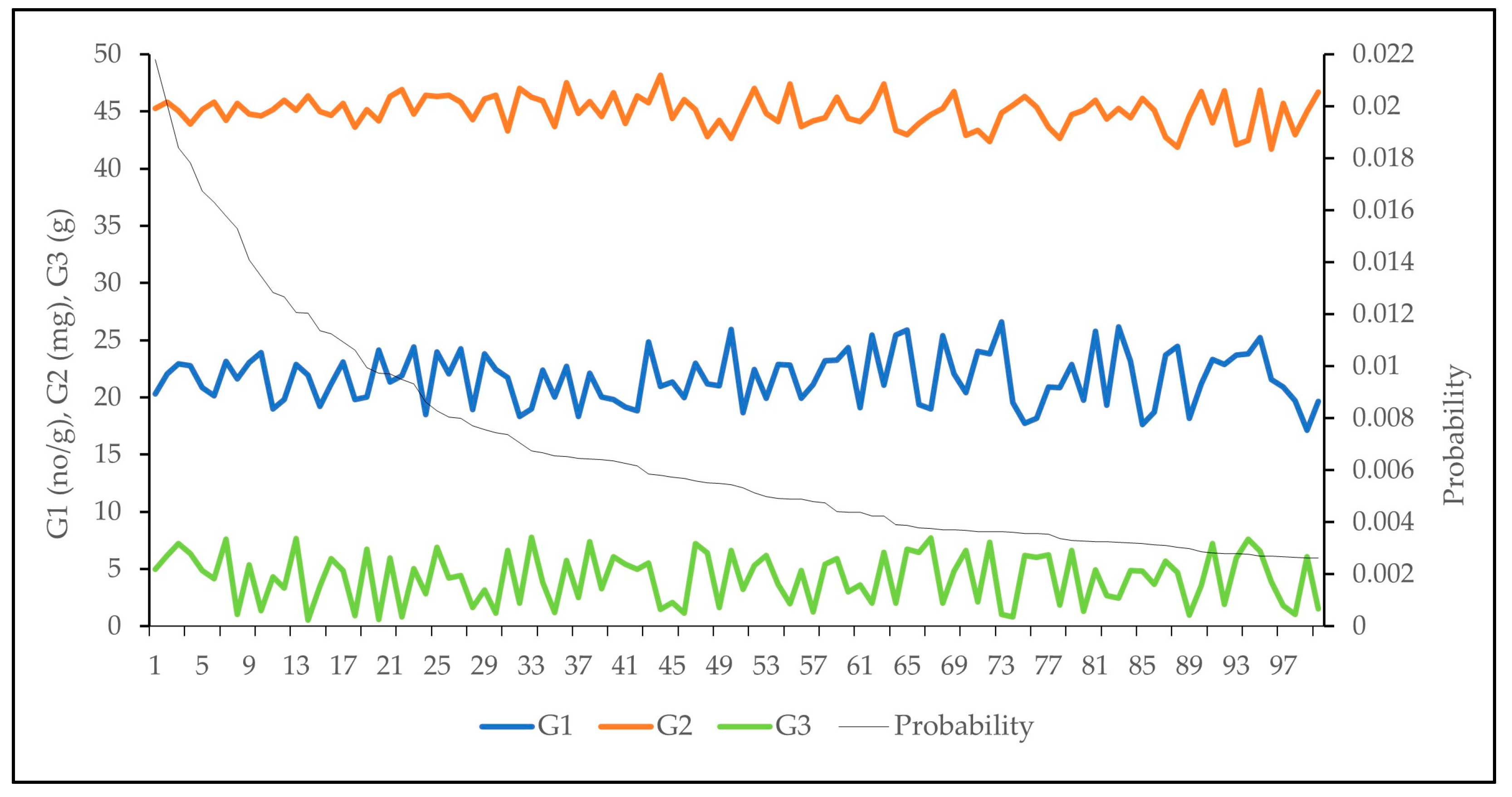
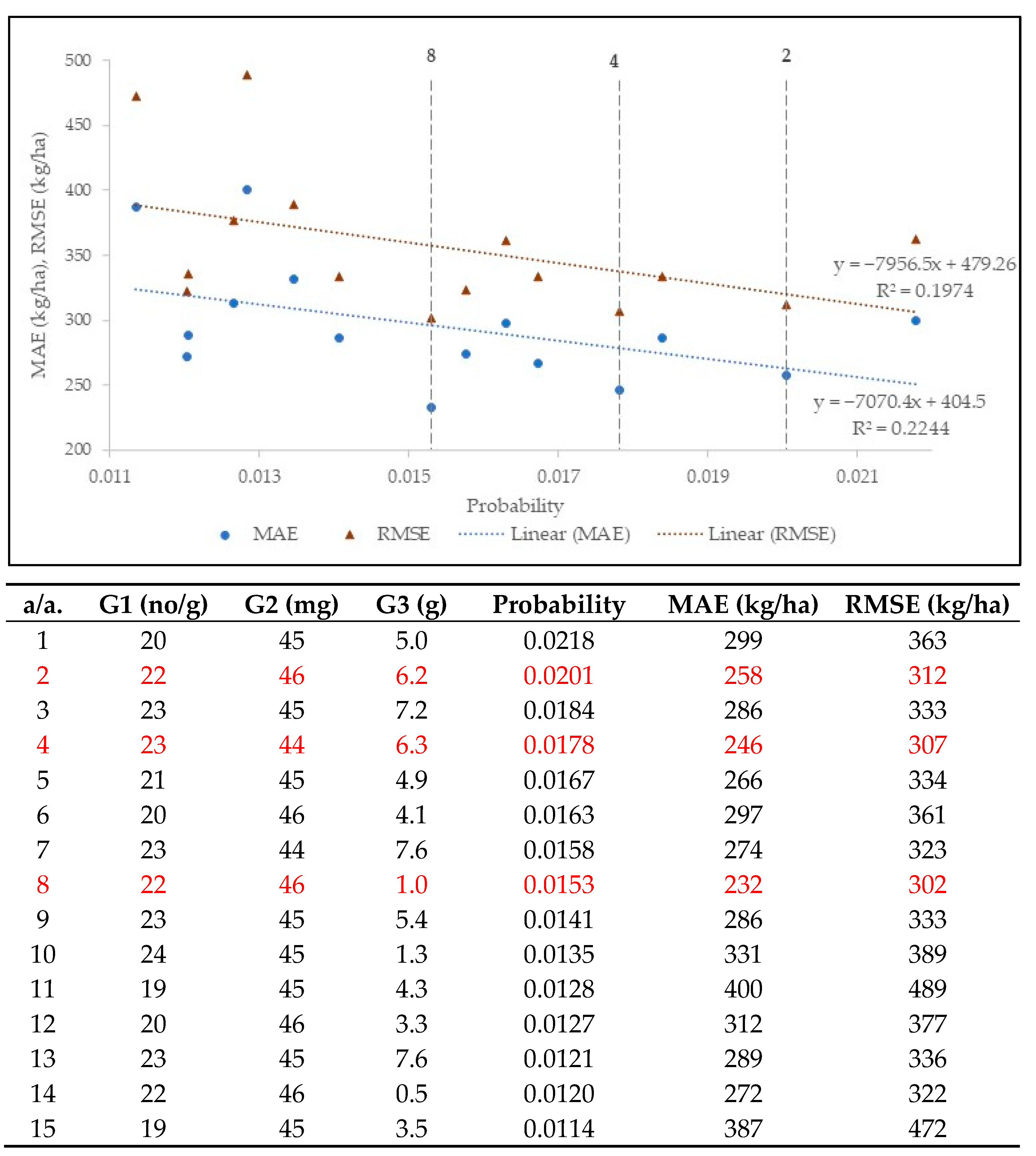

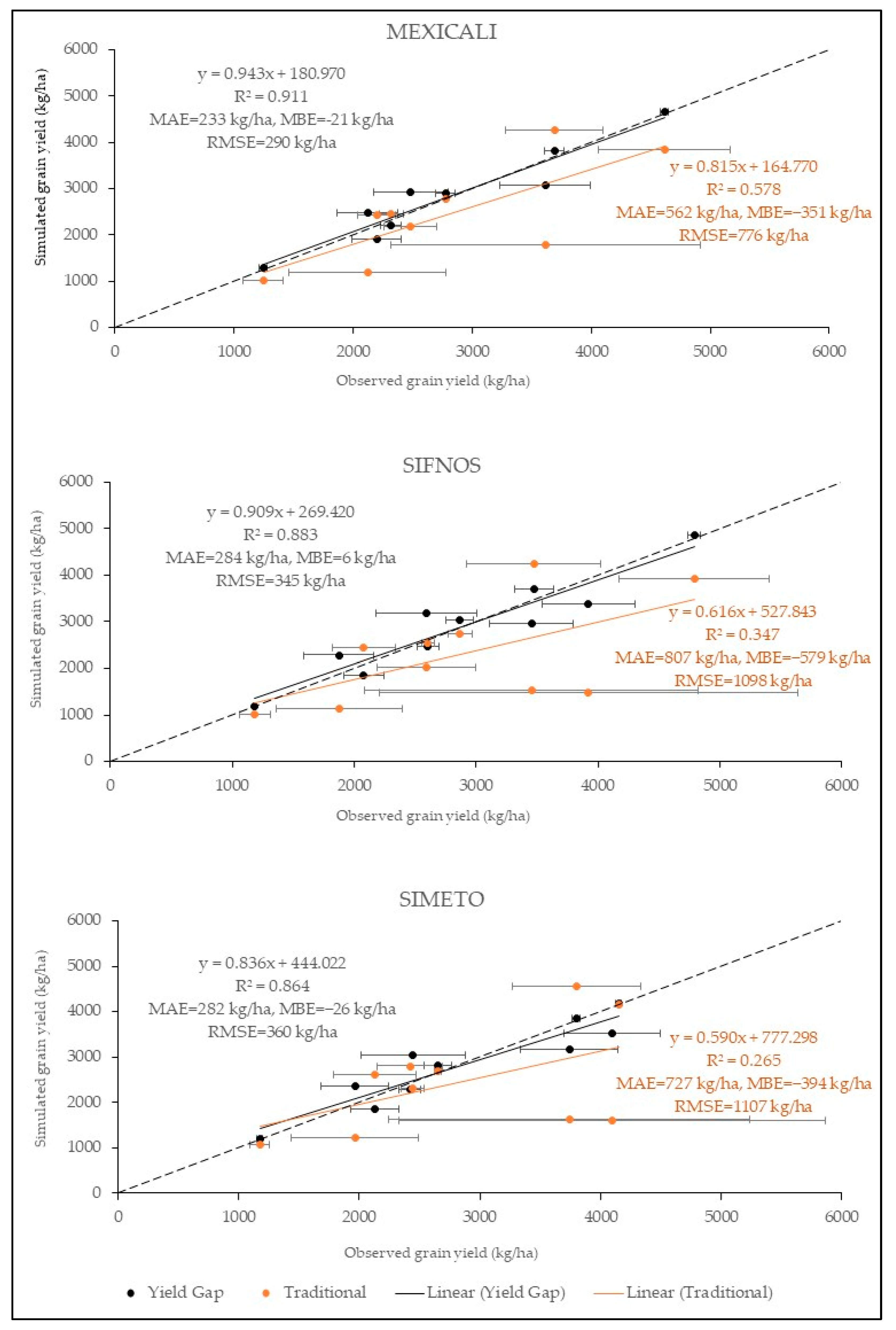
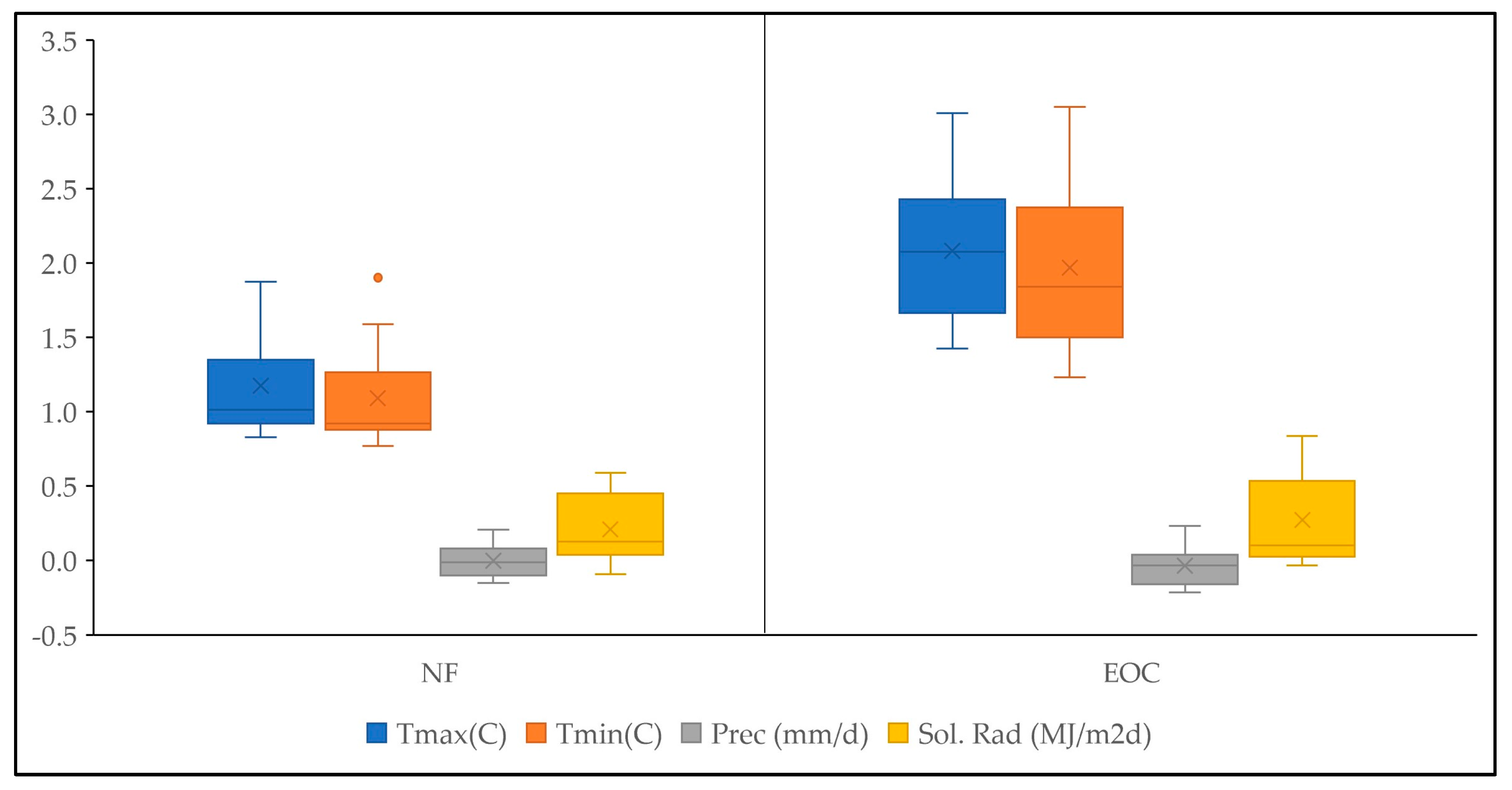
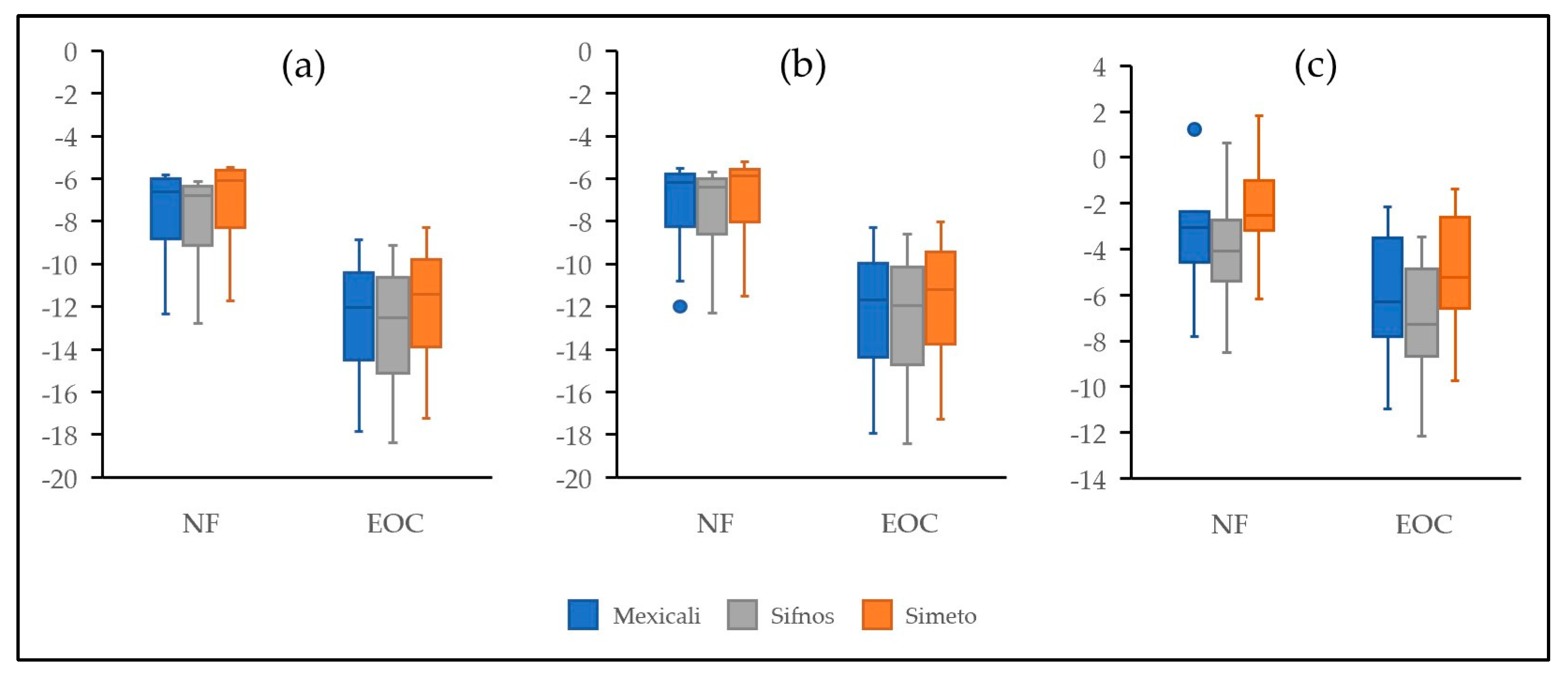
| Parameter | Definition | Unit |
|---|---|---|
| P1V | Days at the optimum vernalizing temperature required to complete vernalization | days |
| P1D | Percentage reduction in development rate in a photoperiod 10 h shorter than the threshold relative to that at the threshold | |
| P5 | Grain filling (excluding lag) phase duration | °C day |
| PHINT | Interval between successive leaf tip appearances | °C day |
| G1 | Kernel number per unit canopy weight at anthesis | nο/g |
| G2 | Standard kernel size under optimum conditions | mg |
| G3 | Standard non-stressed dry weight (including grain) of a single tiller at maturity | g |
| DSSAT v4.7.5 (YgC with Year Adjustment of Yrg (ΥgC_adj)) | |||||||
| Cultivars | 1 P1V | 1 P1D | 1 P5 | 1 G1 | 1 G2 | 1 G3 | 1 PHINT |
| Mexicali | 54 | 51 | 555 | 22 | 46 | 1.5 | 98 |
| Sifnos | 47 | 52 | 530 | 23 | 45 | 0.9 | 99 |
| Simeto | 58 | 59 | 540 | 21 | 45 | 0.9 | 98 |
| DSSAT v4.7.5 (YgC without Year Adjustment of Yrg (YgC_unadj)) | |||||||
| Cultivars | P1V | P1D | P5 | G1 | G2 | G3 | PHINT |
| Mexicali | 54 | 51 | 555 | 18 | 45 | 7.3 | 100 |
| Sifnos | 47 | 52 | 530 | 17 | 45 | 6.9 | 100 |
| Simeto | 58 | 59 | 540 | 17 | 44 | 5.6 | 99 |
| DSSAT v4.7.5 (TrC—Rainfed Mode) | |||||||
| Cultivars | P1V | P1D | P5 | G1 | G2 | G3 | PHINT |
| Mexicali | 54 | 51 | 575 | 13 | 45 | 0.6 | 100 |
| Sifnos | 47 | 52 | 560 | 13 | 46 | 0.7 | 98 |
| Simeto | 58 | 59 | 570 | 14 | 46 | 6.9 | 100 |
| DSSAT v3.5 | |||||||
| Cultivars | P1V | P1D | P5 | G1 | G2 | G3 | PHINT |
| Mexicali | 52 | 32 | 490 | 14 | 58 | 1.7 | 91 |
| Sifnos | 55 | 34 | 500 | 14 | 58 | 2.1 | 93 |
| Simeto | 62 | 37 | 560 | 14 | 56 | 2.1 | 90 |
Disclaimer/Publisher’s Note: The statements, opinions and data contained in all publications are solely those of the individual author(s) and contributor(s) and not of MDPI and/or the editor(s). MDPI and/or the editor(s) disclaim responsibility for any injury to people or property resulting from any ideas, methods, instructions or products referred to in the content. |
© 2023 by the authors. Licensee MDPI, Basel, Switzerland. This article is an open access article distributed under the terms and conditions of the Creative Commons Attribution (CC BY) license (https://creativecommons.org/licenses/by/4.0/).
Share and Cite
Nikou, M.; Mavromatis, T. Demonstrating the Use of the Yield-Gap Concept on Crop Model Calibration in Data-Poor Regions: An Application to CERES-Wheat Crop Model in Greece. Land 2023, 12, 1372. https://doi.org/10.3390/land12071372
Nikou M, Mavromatis T. Demonstrating the Use of the Yield-Gap Concept on Crop Model Calibration in Data-Poor Regions: An Application to CERES-Wheat Crop Model in Greece. Land. 2023; 12(7):1372. https://doi.org/10.3390/land12071372
Chicago/Turabian StyleNikou, Melpomeni, and Theodoros Mavromatis. 2023. "Demonstrating the Use of the Yield-Gap Concept on Crop Model Calibration in Data-Poor Regions: An Application to CERES-Wheat Crop Model in Greece" Land 12, no. 7: 1372. https://doi.org/10.3390/land12071372
APA StyleNikou, M., & Mavromatis, T. (2023). Demonstrating the Use of the Yield-Gap Concept on Crop Model Calibration in Data-Poor Regions: An Application to CERES-Wheat Crop Model in Greece. Land, 12(7), 1372. https://doi.org/10.3390/land12071372








